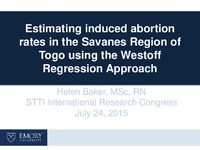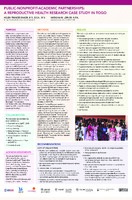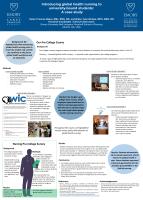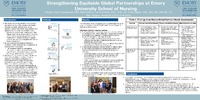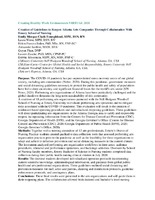| dc.contributor.author | Baker, Helen Frances | en |
| dc.date.accessioned | 2016-03-17T12:55:51Z | |
| dc.date.available | 2016-03-17T12:55:51Z | |
| dc.date.issued | 2016-03-17 | |
| dc.identifier | INRC15D05 | |
| dc.identifier.uri | http://hdl.handle.net/10755/601800 | |
| dc.description | <p>Research Congress 2015 Theme: Question Locally, Engage Regionally, Apply Globally. Held at the Puerto Rico Convention Center.</p> | en |
| dc.description.abstract | <p>Session presented on Friday, July 24, 2015:</p>
<p><strong>Purpose:</strong> Abortion rates are likely the most inaccurate of all demographic data in countries where abortions are illegal. In areas where abortion is legal in most circumstances, it is possible to record the numbers of abortions being performed. In areas where abortion is illegal or highly restricted, there are high levels of underreporting of abortion due to fear, stigma, and shame. In addition, health care workers often do not report providing abortion services due to the legal and moral implications. Induced abortion is a key component of reproductive health; high rates of unsafe abortion contribute to Maternal mortality and morbidity worldwide. In addition, high rates of induced abortion are often strongly associated with an absence of modeRNontraception use. Because of these challenges to researching the actual rates of induced abortions which take place in countries with restrictive abortion laws, numerous methods have been developed to estimate the rates of induced abortion in these areas. One of the newest estimation methods is the Westoff Regression Approach which was developed by Charles Westoff in 2008. This method was developed based on the strong negative correlation between contractive prevalence rates and induced abortion rates in counties with relatively high levels of abortion reporting. The regression formula was based on observations from 18 countries in EasteRNurope and Central Asia. The model was later adapted for use in other geographic regions. The formula used for this analysis was based on an adaptation of the regression model found to closely reflect the actual levels of induced abortion in Nigeria. The purpose of this analysis was to estimate the annual rates of induced abortion in the Savanes region of northeRNogo represented in available data from 1998 Togo Demographic and Health Survey using an adapted Westoff Regression Approach; all abortion in Togo was illegal in 1998.</p>
<p><strong>Methods:</strong> Data from the most recent Demographic and Health Survey (1998) available for Togo were used to estimate the rates of induced abortion in the Savanes region. The data were gathered from the 'Women's Questionnaire' of the Demographic and Health Survey completed by 1679 women aged 15-49 years living in the Savanes region. The regression equation used is as follows: total abortion rate = 2.94-0.033(modeRNontraceptive prevalence rate of ever-married women)-0.252(total fertility rate)+0.091(mean years of education). The annual abortion rates were calculated by the following characteristics: geography, religion, ethnicity, and socioeconomic status. The annual abortion rates were calculated from the total abortion rates. Stata statistical software was used to calculate the age-specific fertility and total fertility rates. SPSS statistical software was used to calculate the modeRNontraceptive prevalence rates and mean years of education. Excel was used to calculate the total abortion rates and annual abortion rates.</p>
<p><strong>Results:</strong> The model estimated the overall annual abortion rate in the Savanes region was 39.12 abortions per 1,000 ever-married women. It was 66.84 per 1,000 ever-married women in the urban areas and 32.99 per 1,000 ever-married women in the rural areas. Dividing the women by religion showed that Muslim women had the highest estimated annual abortion rate at 53.65 per 1,000 ever-married women and women who practiced traditional religions had the lowest rate at 30.77 per 1,000 ever-married women. Dividing the women by ethnicity found that women with a Togolese ethnicity other than Gourma, the predominant ethnicity in the region, had the highest annual abortion rate at 71.06 per 1,000 ever-married women. Women who were a non-Togolese ethnicity had the lowest rate at 35.98 per 1,000 ever-married women. Dividing women by socioeconomic status using the proxy indicator of radio ownership found that women who owned a radio (high socioeconomic status) had an estimated annual abortion rate of 48.10 per 1,000 ever-married women compared to women who did not own a radio (low socioeconomic status) who had an estimated annual abortion rate of 32.00 per 1,000 ever-married women.</p>
<p><strong>Conclusions:</strong> The regression model estimates of the annual abortion rates in the Savanes region of Togo were similar to the estimates done by the Guttmacher Institute for Africa in 1995 and the West African region in 2008 which were 33 and 28 per 1,000 ever-married women aged 15-44 respectively. This shows that the estimates found using the Westoff Regression Approach are likely within a probable range of the actual rates of induced abortion which took place in the Savanes region of Togo in the late 1990s. There are a number of limitations of using the Westoff Regression Approach to estimate annual abortion rates. The model is based on the assumption of a strong negative association between modeRNontraceptive prevalence rates and the number of lifetime abortions per woman and the total fertility rates, but this assumption is mostly based on data from developed countries. In addition, greater use of traditional family planning methods, which is present in Togo, are connected with higher rates of abortion. Other limitations include a lack of a 'gold standard' to evaluate these estimates of annual abortion rates and the inability to calculate annual abortion rates by parity, educational attainment, age, or contraception use due to these variables being used in the model. In addition, most methods of estimating annual abortion rates overestimate the actual abortion rates in countries where modeRNontraceptive use is low and total fertility rates are high, as they are in Togo. While these limitations exist around the use of the Westoff Regression Approach for estimating rates of induced abortion in Togo, because of the extremely limited data which exists on actual rates of induced abortion in this area these estimations provide some insight into the state of induced abortion in the Savanes region of Togo at the tuRNf the 21st century.</p> | en |
| dc.format | Text-based Document | en |
| dc.language.iso | en | en |
| dc.subject | Abortion | en |
| dc.subject | Demographic and Health Surveys | en |
| dc.subject | Reproductive Health | en |
| dc.title | Estimating induced abortion rates in the Savanes Region of Togo, West Africa using the Westoff Regression Approach | en |
| dc.title.alternative | Women's reproductive health | en |
| dc.type | Presentation | en |
| dc.rights.holder | <p>
All rights reserved by the author(s) and/or publisher(s) listed in this item record unless relinquished in whole or part by a rights notation or a Creative Commons License present in this item record.
</p><p>
All permission requests should be directed accordingly and not to the Sigma Repository.
</p><p>
All submitting authors or publishers have affirmed that when using material in their work where they do not own copyright, they have obtained permission of the copyright holder prior to submission and the rights holder has been acknowledged as necessary.
</p> | en |
| dc.description.note | <p>Items submitted to a conference/event were evaluated/peer-reviewed at the time of abstract submission to the event. No other peer-review was provided prior to submission to the Henderson Repository.</p> | |
| dc.type.category | Full-text | en |
| dc.evidence.level | N/A | en |
| dc.research.approach | N/A | en |
| dc.contributor.department | Alpha Epsilon | en |
| dc.author.details | Helen Frances Baker, RN | en |
| dc.conference.name | 26th international Nursing Research Congress | en |
| dc.conference.host | Sigma Theta Tau international | en |
| dc.conference.location | San Juan, Puerto Rico | en |
| dc.date.conferenceyear | 2015 | |
| dc.description.reviewtype | Abstract Review Only: Reviewed by Event Host | en |
| dc.description.acquisition | Proxy-submission | en |
